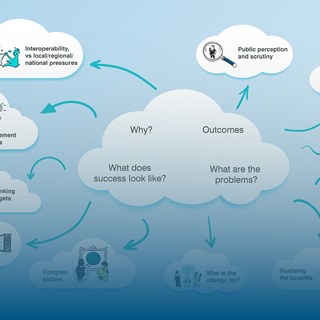
What are the safety considerations for Maritime Autonomous Systems?
As maritime autonomous systems continue to develop at pace, robust regulations and safety assurance measures are required to ensure safety at sea.
9 August 2024
Our safety assurance team have seen an increased demand for their specialist autonomous and uncrewed systems advice to assure safety of life at sea, cargo, and the vessels themselves. Our safety consultant Matt Wylie reflects on the specific considerations that need to be addressed by designers, owners and operators to ensure the transition to new technology is a safe one.
The increasing use of autonomous and uncrewed systems in the maritime domain does indeed reduce the need for human involvement in certain tasks. However, this does not necessarily mean that there are fewer safety considerations! In fact, the shift towards automation introduces a whole new set of safety requirements that need to be addressed.
So, while the nature of safety considerations in maritime activities is changing due to the advent of autonomous and uncrewed systems, the importance of safety and the need for careful consideration of potential risks remain as crucial as ever. It’s an exciting field with many challenges and opportunities for safety engineers.
Autonomy in maritime systems can enhance safety in several ways. It can reduce human error, which is a major cause of accidents, by taking over tasks that are repetitive or require high levels of concentration. These systems can operate continuously, ensuring constant monitoring and control, which is far more difficult with human crew. They can also process large amounts of data quickly and accurately for improved decision making.
Moreover, autonomous systems can replace human operators in dangerous or hazardous environments, reducing the risk to human life. They can predict failures before they occur through continuous monitoring, allowing for preventative maintenance and reducing the risk of system failure as well as being able to navigate with a high degree of accuracy.
While autonomy can significantly enhance safety, it also introduces new risks and challenges that need to be managed, underscoring the importance of safety considerations in the design and operation of autonomous maritime systems.
These challenges highlight the need for careful planning, robust system design, and comprehensive operator training to ensure the safety of remote maritime operations. It’s a complex task, but with the right approach, it can lead to significant operational efficiencies and improvements in safety.
Yes, significantly. The current state of flux can lead to uncertainty about future safety requirements, making it challenging to design systems that will remain compliant. Without established regulations, there’s a lack of standardised safety protocols, leading to inconsistencies in safety management across different systems or operators. Furthermore, as the regulations evolve, systems may need to adapt to stay compliant.
But it’s not all challenges. The lack of rigid, prescriptive regulations can also spur innovation, allowing for the development of novel solutions that might not fit within traditional regulatory frameworks. In these scenarios though it is key to ensure that safety is “baked in” from the onset of the project such that the system can be safe by design, and issues can be avoided later on in the lifecycle.
Moreover, the development of regulations is an opportunity for stakeholders, including safety engineers, to contribute their expertise and shape the industry standards. It’s crucial for those involved in the design and operation of these systems to stay informed about regulatory developments and be prepared to adapt their approaches as needed. This is indeed an exciting time to be working in this field, with the potential to significantly influence the future of maritime safety.
The advancements in maritime autonomy are fascinating, and there are several upcoming developments in the realm of safety that are particularly intriguing.
I’m looking forward to seeing what technological innovations will be introduced in this ever-changing field which will bring safety benefits. The use of improved sensors rapid developments in artificial intelligence and machine learning is opening up new possibilities; we are seeing larger vessels being operated without crew used in increasingly complex operations at sea that would have been deemed impossible not so long ago.
From a safety and regulatory standpoint, the most fascinating development I’m waiting to see is the International Maritime Organization (IMO) integrating autonomous and remote operation technologies into its regulatory framework. This includes the development of a non-mandatory goal-based MASS Code, expected to take effect in 2025, which will lay the groundwork for a mandatory code set to enter into force by 2032. This framework will allow for a harmonised global approach to safety management of Maritime Autonomous Systems, and will hopefully allow for a better understanding of safety requirements and a simpler route to gaining class and flag approval than currently exists.

Matt Wylie is a Senior Safety Consultant at BMT. He provides safety assurance expertise to several customers, working with novel and emerging technologies. Matt has extensive experience developing safety cases for autonomous and remote-control surface ships, particularly in the risk assessment phase of safety case development.

N/A
Delve into the top 10 challenges and interdependencies involved in selecting and adopting from the plethora of technological developments, and then embedding multiple new technologies in frontline UK policing, highlighting the multifaceted nature of this undertaking.

N/A
Get ready to dive deep into maritime autonomy as we bring you technical experts, insightful opinions, and unmissable discussions.

Jake Rigby
We explore the core elements of the support framework required to ensure Persistent Operational Deployable Systems (PODS) can thrive.

N/A
BMT papers which explore the latest insights on the future of maritime autonomy and the safety of autonomous vessels.